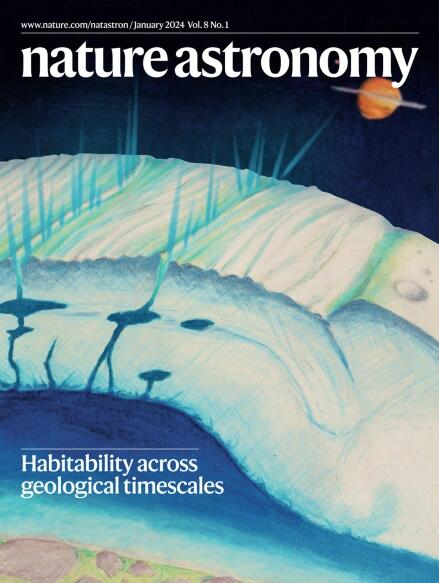月球南极-艾特肯盆地 43.3 亿年年龄的证据
IF 12.9
1区 物理与天体物理
Q1 ASTRONOMY & ASTROPHYSICS
引用次数: 0
摘要
月球远侧的南极-艾特肯(SPA)盆地是内太阳系最大和最古老的可见撞击盆地。确定这一灾难性事件发生的时间是了解月球盆地形成纪元开始的关键,对了解内太阳系的撞击轰击历史具有重要意义。尽管如此,SPA 盆地的形成年龄仍然难以确定。在这里,我们展示了西北非 2995 号月球陨石的化学成分与 SPA 盆地南部地区出露的岩性十分吻合。对西北非 2995 中的一系列矿物和岩石成分进行的辐射测定得出了一致的年代,即距今约 43.2-43.3 亿年。我们将这些日期解释为 SPA 盆地形成的年龄,推断这一事件发生在 ~4.2 Ga 到 3.8 Ga 之间月球撞击盆地主群形成之前 ~1.2 亿年。这削弱了对月球晚期重型撞击轰击时期狭窄的支持,也意味着月球上最早形成的撞击盆地(即 4.33-4.5 Ga)在 SPA 撞击形成时导致月球表面大规模重铺,或者通过其他地质过程被抹去了。本文章由计算机程序翻译,如有差异,请以英文原文为准。


Evidence of a 4.33 billion year age for the Moon’s South Pole–Aitken basin
The Moon’s farside South Pole–Aitken (SPA) basin is the largest and oldest visible impact basin in the inner Solar System. Determining the timing of this catastrophic event is key to understanding the onset of the lunar basin-forming epoch, with implications for understanding the impact bombardment history of the inner Solar System. Despite this, the formation age of the SPA basin remains poorly constrained. Here we show that the chemical composition of the lunar meteorite Northwest Africa 2995 is in good agreement with lithologies exposed within the southern region of the SPA basin. Radiometric dating of a range of mineral and rock components in Northwest Africa 2995 yielded consistent dates of ~4.32–4.33 billion years old. We interpret these dates as the age of SPA basin formation, inferring that this event occurred ~120 million years before the formation of the main cluster of lunar impact basins between ~4.2 Ga and 3.8 Ga. This weakens support for a narrow period of lunar late heavy impact bombardment and also implies that the earliest formed impact basins on the Moon (that is, >4.33–4.5 Ga old) were erased either by the SPA impact itself when its formation caused massive resurfacing of the lunar surface or through other geological processes. A lunar meteorite sample called Northwest Africa 2995 probably originated from the South Pole–Aitken basin on the Moon’s farside. Minerals in the meteorite date basin formation to 4.32–4.33 billion years ago.
求助全文
通过发布文献求助,成功后即可免费获取论文全文。
去求助
来源期刊

Nature Astronomy
Physics and Astronomy-Astronomy and Astrophysics
CiteScore
19.50
自引率
2.80%
发文量
252
期刊介绍:
Nature Astronomy, the oldest science, has played a significant role in the history of Nature. Throughout the years, pioneering discoveries such as the first quasar, exoplanet, and understanding of spiral nebulae have been reported in the journal. With the introduction of Nature Astronomy, the field now receives expanded coverage, welcoming research in astronomy, astrophysics, and planetary science. The primary objective is to encourage closer collaboration among researchers in these related areas.
Similar to other journals under the Nature brand, Nature Astronomy boasts a devoted team of professional editors, ensuring fairness and rigorous peer-review processes. The journal maintains high standards in copy-editing and production, ensuring timely publication and editorial independence.
In addition to original research, Nature Astronomy publishes a wide range of content, including Comments, Reviews, News and Views, Features, and Correspondence. This diverse collection covers various disciplines within astronomy and includes contributions from a diverse range of voices.
 求助内容:
求助内容: 应助结果提醒方式:
应助结果提醒方式:


